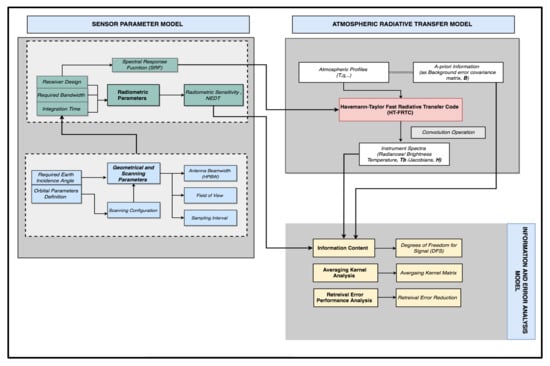End-to-End Instrument Performance Simulation System (EIPS) Framework: Application to Satellite Microwave Atmospheric Sounding Systems
Abstract
1. Introduction
2. Satellite Atmospheric Observing System Design
- Sensor modelling: this should take account of all the instrument system parameters that can affect the measurement of the signal such as: spectral response function (SRF), detector noise etc.,
- Atmospheric radiative transfer modelling: modelling of the propagation of EM radiation through the earth’s atmosphere,
- Inversion algorithm: an algorithm is required to retrieve the geophysical variables of interest and to test their accuracy and sensitivity to other factors.
3. The End-to-End Instrument Performance Simulation System (EIPS) Framework
3.1. EIPS Block Design and Organisation
3.2. EIPS Components
3.2.1. Sensor Parameter Model
3.2.2. Atmospheric Radiative Transfer Model: The HT-FRTC
3.2.3. Sensor Component of the HT-FRTC
3.2.4. Information and Error Analysis Model
3.2.4.1. Theory of Optimal Estimation
3.2.4.2. Retrievals and performance diagnostics
- Jacobian Matrix: The elements of the Jacobian matrix provides the sensitivity of the satellite measurements with respect to the target atmospheric parameters. These Jacobians play an important role in the spectral channels design and placement in the EM spectrum. The mathematical expression for the Jacobian matrix is given by the following Equation (5):
- Retrieval Errors: Retrieval errors are given by the square root of diagonal elements of analysis error covariance matrix . Comparison of analysis errors with the background errors gives the reduction in the retrieval error, and which is also a measure of retrieval error performance of an instrument. Retrieval and background errors can be calculated by the mathematical expressions (6) and (7) respectively:where and are the elements on the ith row and ith column of A and B matrix respectively and denotes the leading diagonal of the matrix.
- Averaging Kernels: Averaging kernels are defined as the sensitivity of the retrieval state with respect to the true state of the atmosphere. Mathematically, these averaging kernels can be formulated as:where is the averaging kernel matrix, is the retrieved atmospheric parameter and is true state of the atmospheric parameter.
- Degrees of Freedom for Signal (DFS): Information content is another important diagnostic for measuring the performance of an atmospheric observing system. Information content of satellite measurements can be estimated by comparing retrieval error covariance matrix with the background error covariance matrix . In the context of EIPS framework, the Degrees of Freedom for Signal (DFS) has been incorporated as the measure of information content, and it is given by the Equation (9):where is the degrees of freedom for signal, and tr (.) denotes the trace of a matrix.
4. Example of Application: Performance Simulations using the EIPS framework
4.1. End-to-End Simualtion Settings and Inputs
4.2. Microwave System Configurations
4.2.1. Configuration A: ATMS-Type and Configuration B: AMSU-A-Type
4.2.2. Configuration C: TES-Based MW Instrument
4.3. Performance Simulations Analysis Using EIPS Framework
4.3.1. Channel Jacobians Simulations
4.3.2. Averaging Kernels and Information Content Estimation
4.3.3. Retrieval Error Performance Simulations
5. Conclusions
Author Contributions
Acknowledgments
Conflicts of Interest
Abbreviations
| AMSU-A | Advanced Microwave Sounding Unit-A |
| AMSU-B | Advanced Microwave Sounding Unit-B |
| AOSD | Atmospheric Observing System Design |
| ATMS | Advanced Technology Microwave Sounder |
| DFS | Degrees of Freedom for Signal |
| ECMWF | European Centre for Medium-Range Weather Forecasts |
| EIPS | End-to-End Instrument Performance Simulation System |
| EM | Electromagnetic |
| HT-FRTC | Havemann-Taylor Fast Radiative Transfer Code |
| IASI | Infrared Atmospheric Sounding Interferometer |
| ICI | Ice Cloud Imager |
| IR | InfraRed |
| MAP | Maximum-a-posteriori |
| MetOp | Meteorological Operational |
| MHS | Microwave Humidity Sounder |
| MW | Microwave |
| MWI | MicroWave Imager |
| MWS | MicroWave Sounder |
| NETD | Noise Equivalent Temperature Difference |
| NWP | Numerical Weather Prediction |
| OE | Optimal Estimation |
| PC | Principal Component |
| PCA | Principal Component Analysis |
| SRF | Spectral Response Function |
| TES | Transition Edge Sensor |
| UM | Unified Model |
| UV | Ultraviolet |
References
- Joo, S.; Eyre, J.; Marriott, R. The Impact of MetOp and Other Satellite Data within the Met Office Global NWP System Using an Adjoint-Based Sensitivity Method. Mon. Weather Rev. 2013, 141, 3331–3342. [Google Scholar] [CrossRef]
- Geer, A.J.; Bauer, P. Observation errors in all-sky data assimilation. Q. J. R. Meteorol. Soc. 2011, 137, 2024–2037. [Google Scholar] [CrossRef]
- Zhu, Y.; Gelaro, R. Observation Sensitivity Calculations Using the Adjoint of the Gridpoint Statistical Interpolation (GSI) Analysis System. Mon. Weather Rev. 2008, 136, 335–351. [Google Scholar] [CrossRef]
- Cardinali, C. Monitoring the observation impact on the short-range forecast. Q. J. R. Meteorol. Soc. 2009, 135, 239–250. [Google Scholar] [CrossRef]
- Collard, A.D.; McNally, A.P. The assimilation of Infrared Atmospheric Sounding Interferometer radiances at ECMWF. Q. J. R. Meteorol. Soc. 2009, 135, 1044–1058. [Google Scholar] [CrossRef]
- Radnóti, G.; Bauer, P.; McNally, A.; Cardinali, C.; Healy, S.; de Rosnay, P. ECMWF Study on the Impact of Future Developments of the Space-Based Observing System on Numerical Weather Prediction. ECMWF. December 2010. Available online: https://www.ecmwf.int/en/elibrary/11815-ecmwf-study-impact-future-developments-space-based-observing-system-numerical (accessed on 26 March 2019).
- McNally, A. Observing System Experiments to Assess the Impact of Possible Future Degradation of the Global Satellite Observing Network. ECMWF. March 2012. Available online: https://www.ecmwf.int/en/elibrary/11085-observing-system-experiments-assess-impact-possible-future-degradation-global (accessed on 26 March 2019).
- McNally, T.; Bonavita, M.; Thépaut, J.-N. The Role of Satellite Data in the Forecasting of Hurricane Sandy. Mon. Weather Rev. 2014, 142, 634–646. [Google Scholar] [CrossRef]
- English, S.J.; McNally, A.; Bormann, N.; Salonen, K.; Matricardi, M.; Horányi, A.; Rennie, M.; Janiskova, M.; Di Michele, S.; Geer, A.; et al. Impact of Satellite Data. ECMWF. October 2013. Available online: https://www.ecmwf.int/en/elibrary/9301-impact-satellite-data (accessed on 26 March 2019).
- Lerner, J.A. Temperature and humidity retrieval from simulated Infrared Atmospheric Sounding Interferometer (IASI) measurements. J. Geophys. Res. 2002, 107. [Google Scholar] [CrossRef]
- Rosenkranz, P.W. Retrieval of temperature and moisture profiles from AMSU-A and AMSU-B measurements. IEEE Trans. Geosci. Remote Sens. 2001, 39, 2429–2435. [Google Scholar] [CrossRef]
- Pearson, K.; Merchant, C.; Embury, O.; Donlon, C. The Role of Advanced Microwave Scanning Radiometer 2 Channels within an Optimal Estimation Scheme for Sea Surface Temperature. Remote Sens. 2018, 10, 90. [Google Scholar] [CrossRef]
- Kangas, V.; D’Addio, S.; Betto, M.; Barre, H.; Mason, G. MetOp Second Generation Microwave radiometers. In Proceedings of the 2012 12th Specialist Meeting on Microwave Radiometry and Remote Sensing of the Environment (MicroRad), Rome, Italy, 5–9 March 2012; pp. 1–4. [Google Scholar]
- Alberti, G.; Memoli, A.; Pica, G.; Santovito, M.R.; Buralli, B.; Varchetta, S.; D’addio, S.; Kangas, V. TWO Microwave Imaging radiometers for MetOp Second Generation. In Proceedings of the 2012 Tyrrhenian Workshop on Advances in Radar and Remote Sensing (TyWRRS), Naples, Italy, 12–14 September 2012; pp. 243–246. [Google Scholar]
- Bizzarri, B.; Gasiewski, A.; Staelin, D. Initiatives for millimetre/submillimetre-wave sounding from geostationary orbit. In Proceedings of the IEEE International Geoscience and Remote Sensing Symposium, Toronto, ON, Canada, 24–28 June 2002; Volume 1, pp. 548–552. [Google Scholar]
- Thomas, C.; Goldie, D.J.; Withington, S.; Hargrave, P.; Orlando, A.; Sudiwala, R.; Dongre, P.K. Transition Edge Sensor Superconducting Filterbank Spectrometers for Hyperspectral Microwave Atmospheric Sounding. In Proceedings of the 8th ESA Workshop on Millimetre-Wave Technology and Applications (in press); ESA-ESTEC, Noordwijk, The Netherlands, 10–12 December 2018; p. Session 5A.
- McMillin, L.M.; Fleming, H.E. Trade-Offs in the Design of Satellite Sounding Instruments. J. Atmospheric Ocean. Technol. 1985, 2, 278–284. [Google Scholar] [CrossRef]
- Rodgers, C.D. Inverse Methods for Atmospheric Sounding: Theory and Practice; Series on Atmospheric, Oceanic and Planetary Physics; World Scientific: Singapore, 2000; Volume 2, ISBN 978-981-02-2740-1. [Google Scholar]
- Havemann, S.; Thelen, J.-C.; Taylor, J.P.; Harlow, R.C. The Havemann-Taylor Fast Radiative Transfer Code (HT-FRTC): A multipurpose code based on principal components. J. Quant. Spectrosc. Radiat. Transf. 2018, 220, 180–192. [Google Scholar] [CrossRef]
- Newman, S.M.; Clarisse, L.; Hurtmans, D.; Marenco, F.; Johnson, B.; Turnbull, K.; Havemann, S.; Baran, A.J.; O’Sullivan, D.; Haywood, J. A case study of observations of volcanic ash from the Eyjafjallajökull eruption: 2. Airborne and satellite radiative measurements: Eyjafjallajökull radiative case study. J. Geophys. Res. Atmos. 2012, 117. [Google Scholar] [CrossRef]
- Athanassiadou, M.; Francis, P.N.; Saunders, R.W.; Atkinson, N.C.; Hort, M.C.; Havemann, S.; Thelen, J.-C.; Bush, M. A case study of sulphur dioxide identification in three different volcanic eruptions, using Infrared satellite observations (IASI): Volcanic SO 2 detection from IASI. Meteorol. Appl. 2016, 23, 477–490. [Google Scholar] [CrossRef]
- Aumann, H.H.; Chen, X.; Fishbein, E.; Geer, A.; Havemann, S.; Huang, X.; Liu, X.; Liuzzi, G.; DeSouza-Machado, S.; Manning, E.M.; et al. Evaluation of Radiative Transfer Models with Clouds. J. Geophys. Res. Atmos. 2018, 123, 6142–6157. [Google Scholar] [CrossRef]
- Baran, A.J.; Furtado, K.; Labonnote, L.-C.; Havemann, S.; Thelen, J.-C.; Marenco, F. On the relationship between the scattering phase function of cirrus and the atmospheric state. Atmos. Chem. Phys. 2015, 15, 1105–1127. [Google Scholar] [CrossRef]
- Thelen, J.-C.; Havemann, S.; Taylor, J.P. Atmospheric Correction of Short-Wave Hyperspectral Imagery Using a Fast, Full-Scattering 1DVar Retrieval Scheme; Shen, S.S., Lewis, P.E., Eds.; SPIE: Baltimore, MD, USA, 2012; p. 839010. [Google Scholar]
- Gristey, J.J.; Chiu, J.C.; Gurney, R.J.; Shine, K.P.; Havemann, S.; Thelen, J.-C.; Hill, P.G. Short-wave spectral radiative signatures and their physical controls. J. Clim. 2019. [Google Scholar] [CrossRef]
- Smith, F.; Havemann, S.; Hoffmann, A.; Bell, W.; Weidmann, D.; Newman, S. Evaluation of laser heterodyne radiometry for numerical weather prediction applications. Q. J. R. Meteorol. Soc. 2018, 144, 1831–1850. [Google Scholar] [CrossRef]
- Matricardi, M. The Generation of RTTOV Regression Coefficients for IASI and AIRS Using a New Profile Training Set and a New Line-by-Line Database. ECMWF. May 2008. Available online: https://www.ecmwf.int/en/elibrary/11040-generation-rttov-regression-coefficients-iasi-and-airs-using-new-profile-training (accessed on 26 March 2019).
- Ide, K.; Courtier, P.; Ghil, M.; Lorenc, A.C. Unified Notation for Data Assimilation: Operational, Sequential and Variational (gtSpecial IssueltData Assimilation in Meteology and Oceanography: Theory and Practice). J. Meteorol. Soc. Jpn. Ser. II 1997, 75, 181–189. [Google Scholar] [CrossRef]
- Smith, F.I. Improving the Information Content of IASI Assimilation for Numerical Weather Prediction. Ph.D. Thesis, University of Leicester, Leicester, UK, 2015. [Google Scholar]
- Eyre, J.R.; Hilton, F.I. Sensitivity of analysis error covariance to the mis-specification of background error covariance. Q. J. R. Meteorol. Soc. 2013, 139, 524–533. [Google Scholar] [CrossRef]
- Sato, T.O.; Sato, T.M.; Sagawa, H.; Noguchi, K.; Saitoh, N.; Irie, H.; Kita, K.; Mahani, M.E.; Zettsu, K.; Imasu, R.; et al. Vertical profile of tropospheric ozone derived from synergetic retrieval using three different wavelength ranges, UV, IR, and microwave: Sensitivity study for satellite observation. Atmos. Meas. Tech. 2018, 11, 1653–1668. [Google Scholar] [CrossRef]

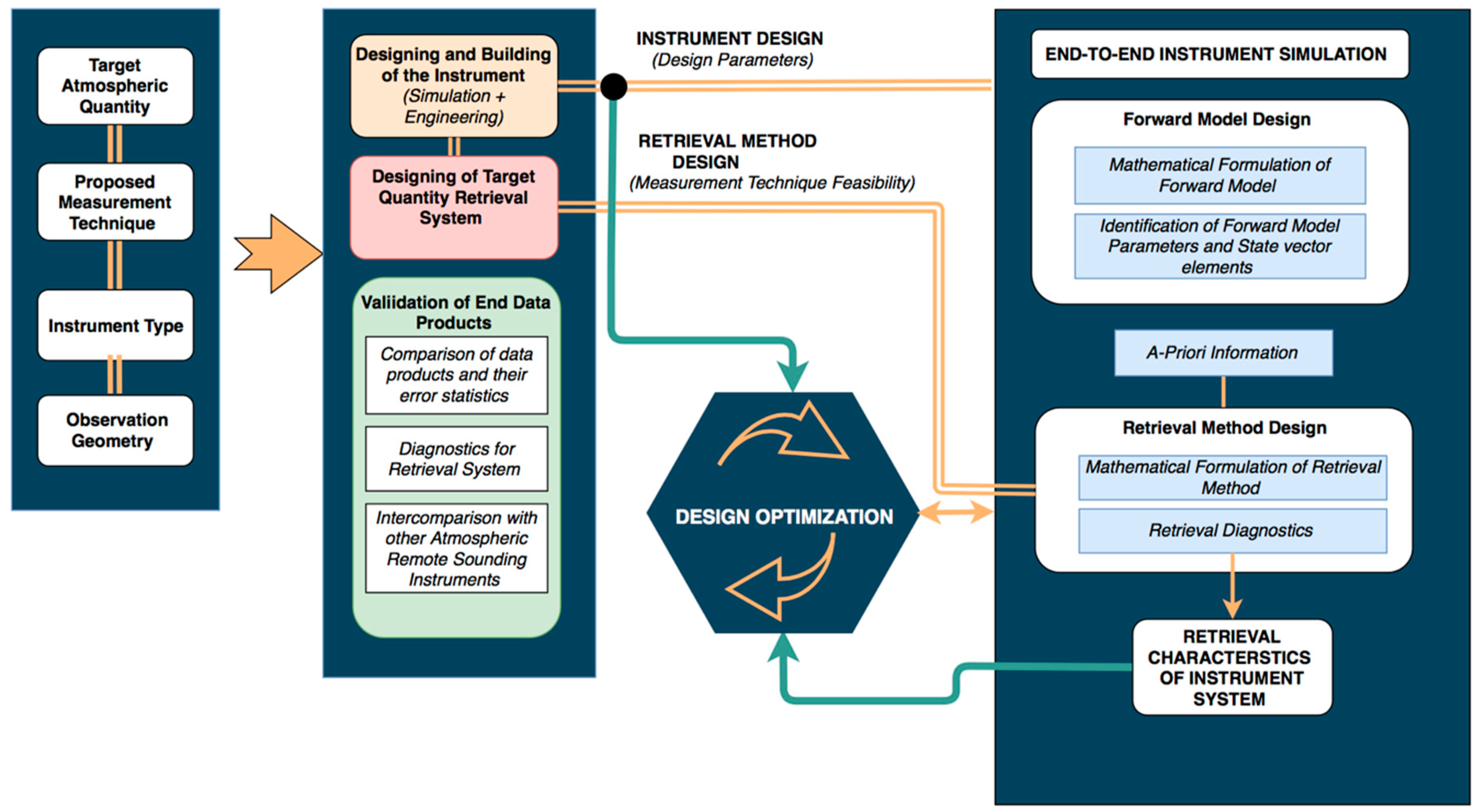

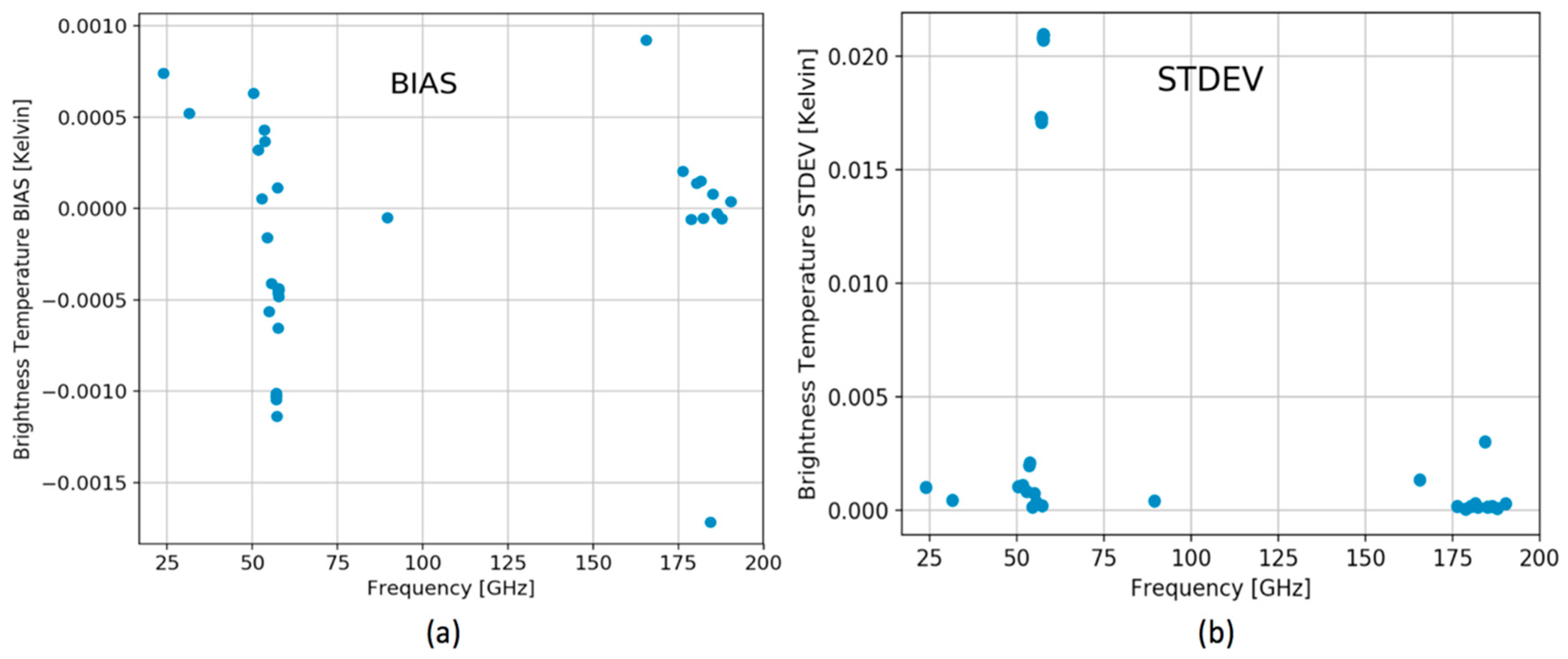
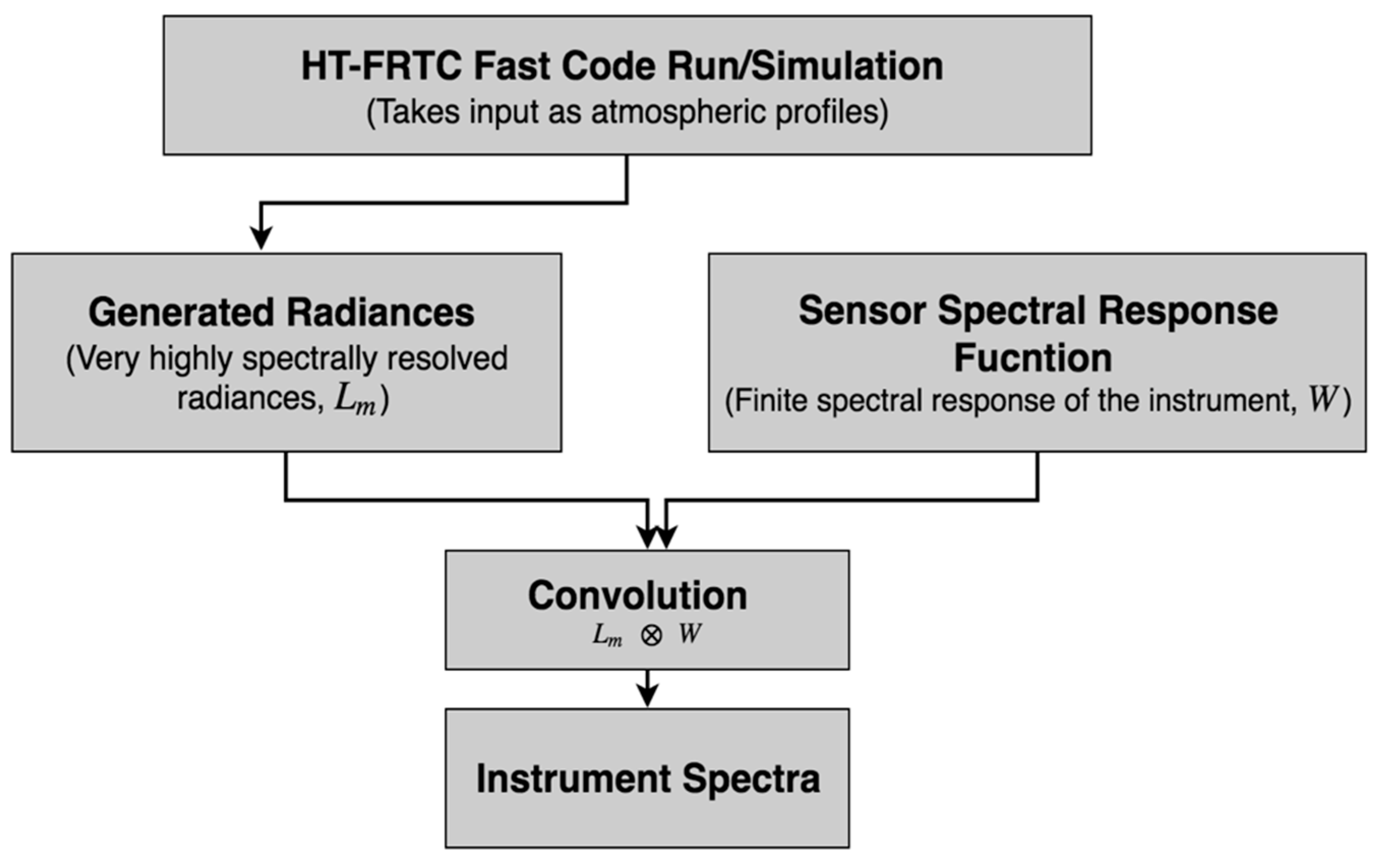
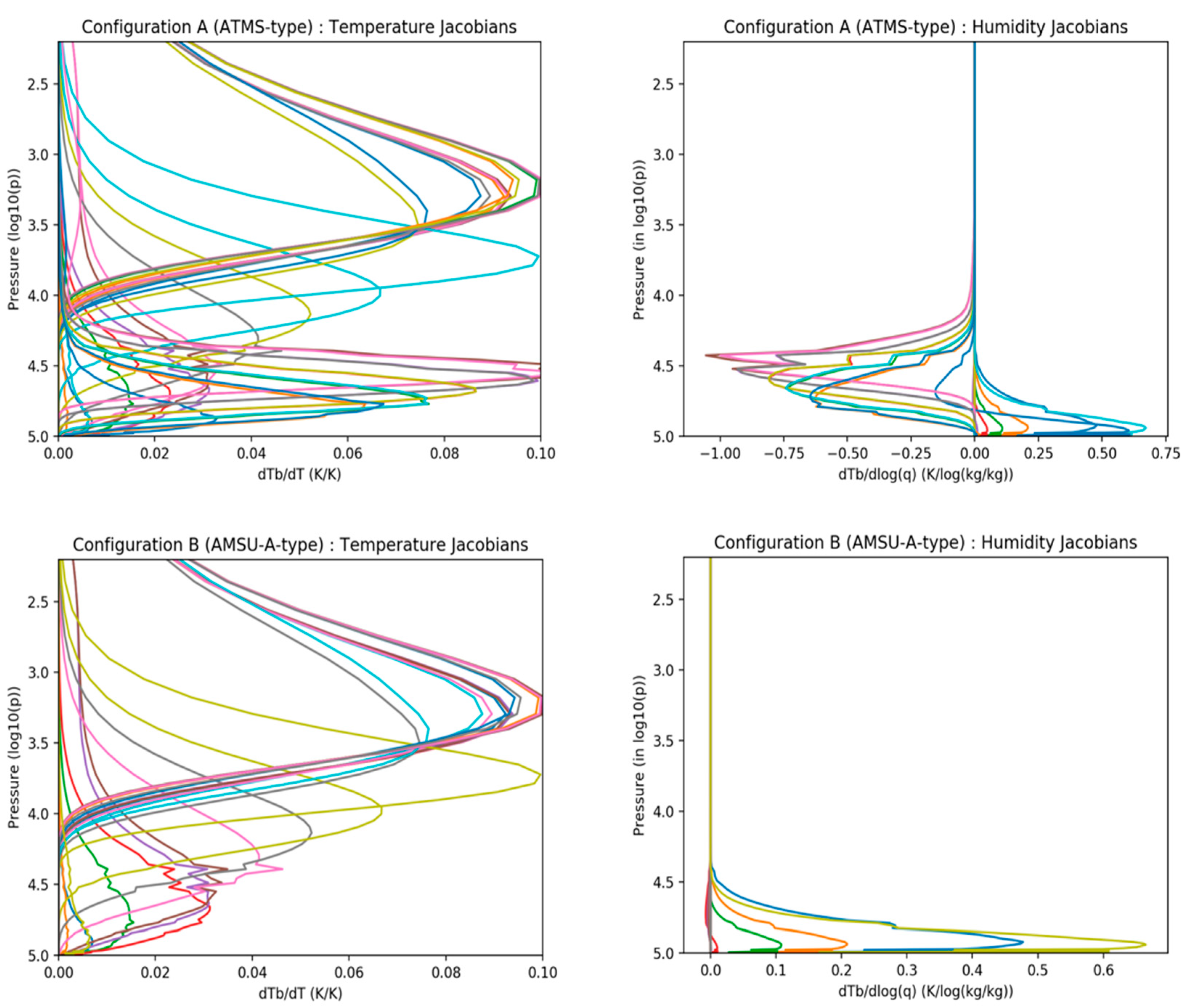
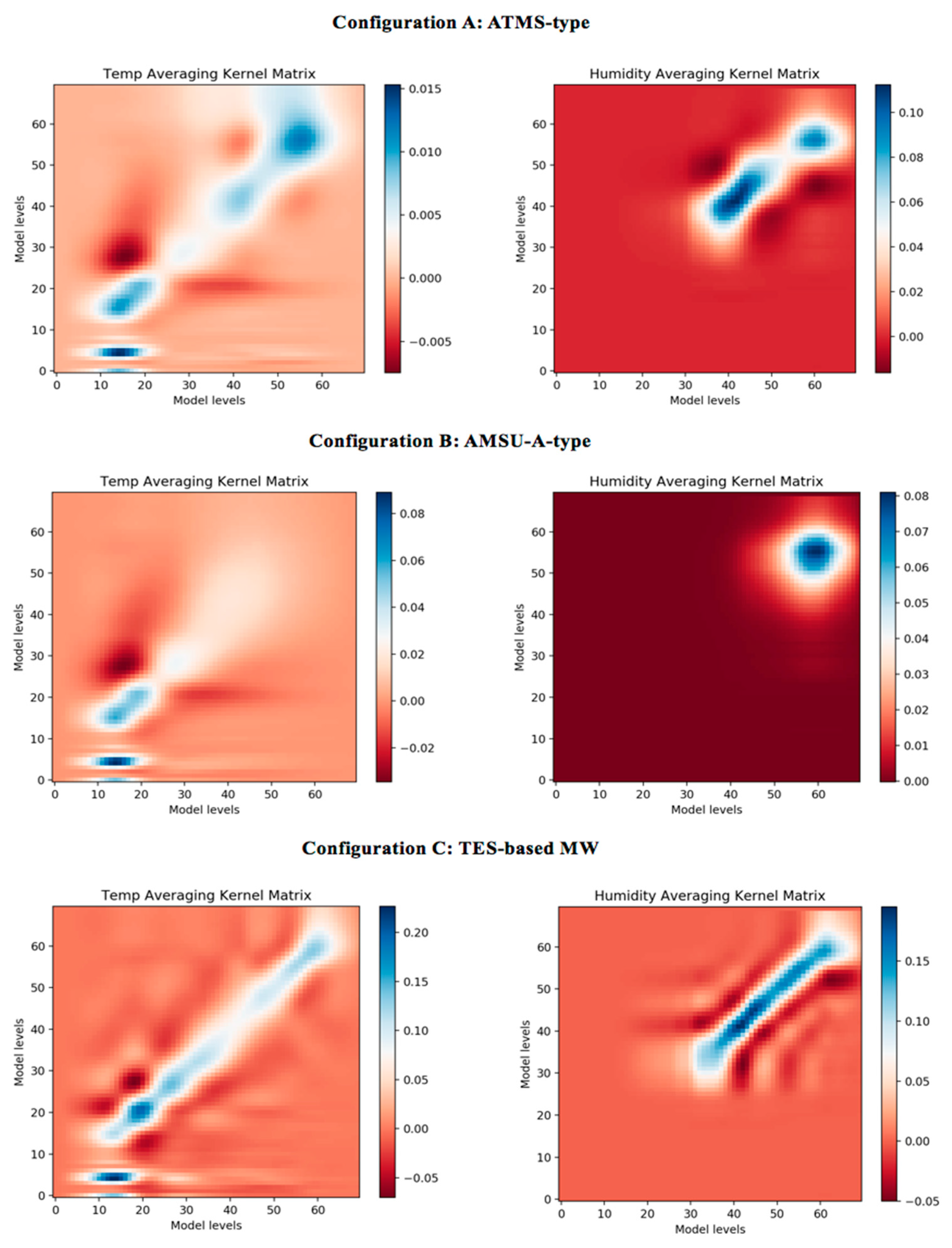
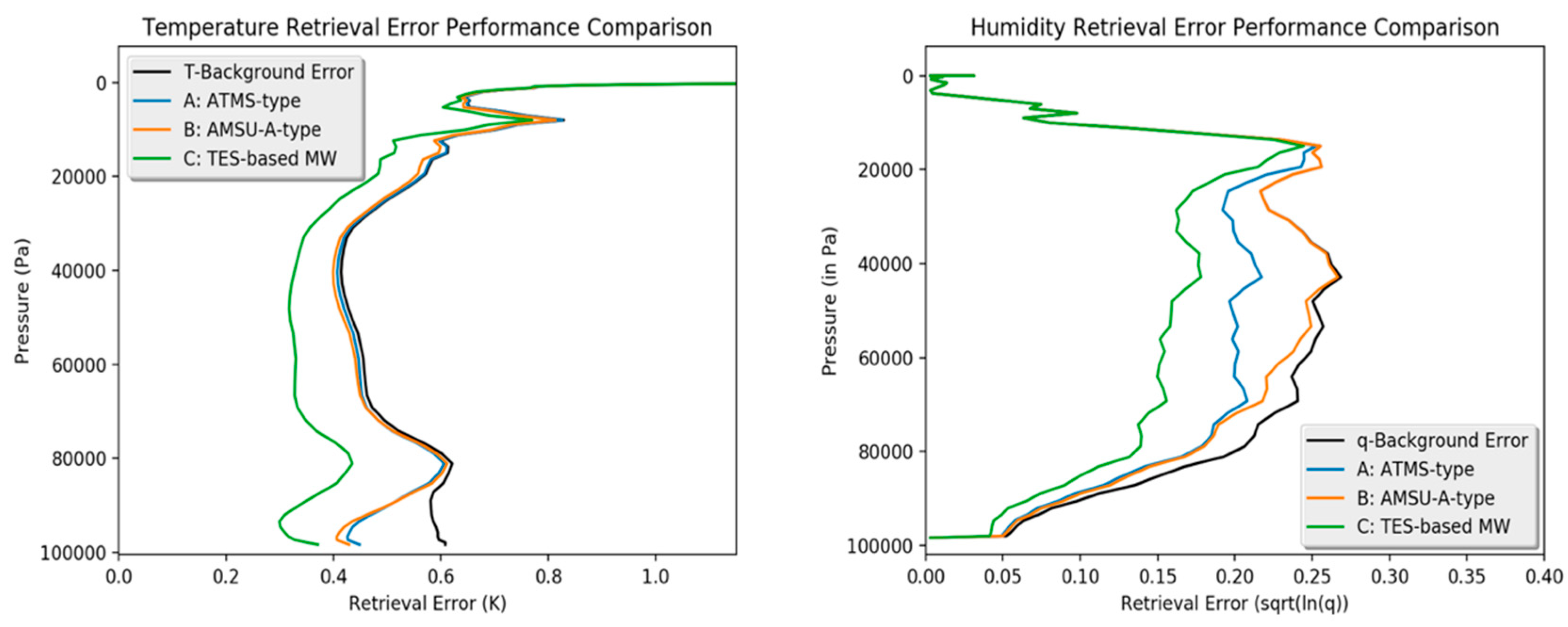
| System Parameters | Settings |
|---|---|
| Geometrical configuration | Sensor zenith angle 53 degree, fixed single field of view is considered |
| Spectral Range | 23 GHz- 183 GHz (for all the configurations A, B and C) |
| Centre Frequency (GHz) | Bandwidth (MHz) | Application | NETD of MW System Configurations (K) | ||
|---|---|---|---|---|---|
| (A) ATMS-Type | (B) AMSU-A-Type | (C) TES-Based MW | |||
| 23.8 * | 270 | Window-Water vapour | 0.9 | 0.3 | 0.025 |
| 31.4 * | 180 | Window-water vapour | 0.9 | 0.3 | 0.038 |
| 50.3 * | 180 | Window-surface emissivity | 1.2 | 0.4 | 0.038 |
| 51.7 | 400 | Window-surface emissivity | 0.75 | 0.25 | 0.017 |
| 52.8 * | 400 | Temperature | 0.75 | 0.25 | 0.017 |
| 53.596 ± 0.115 * | 170 | 0.75 | 0.25 | 0.041 | |
| 54.40 * | 400 | 0.75 | 0.25 | 0.017 | |
| 54.94 * | 400 | 0.75 | 0.25 | 0.017 | |
| 55.50 * | 330 | 0.75 | 0.25 | 0.021 | |
| 57.290344 * | 330 | 0.75 | 0.25 | 0.021 | |
| 57.290344 ± 0.217 * | 78 | 1.20 | 0.40 | 0.089 | |
| 57.290344 ± 0.3222 ± 0.048 * | 36 | 1.20 | 0.40 | 0.192 | |
| 57.290344 ± 0.3222 ± 0.022 * | 16 | 1.50 | 0.60 | 0.433 | |
| 57.290344 ± 0.3222 ± 0.010 * | 8 | 2.40 | 0.80 | 0.865 | |
| 57.290344 ± 0.3222 ± 0.0045 * | 3 | 3.60 | 1.20 | 2.308 | |
| 89.0 * | 6000 | Window | 0.50 | 0.50 | |
| 89.5 | 5000 | 0.50 | 0.001 | ||
| 165.5 | 3000 | Water-vapour | 0.60 | 0.002 | |
| 183.31 ± 7.0 | 2000 | 0.80 | 0.004 | ||
| 183.31 ± 4.5 | 2000 | 0.80 | 0.004 | ||
| 183.31 ± 3.0 | 1000 | 0.80 | 0.007 | ||
| 183.31 ± 1.8 | 1000 | 0.80 | 0.007 | ||
| 183.31 ± 1.0 | 500 | 0.90 | 0.014 | ||
| MW System Configuration | Average DFS (Over Eight Atmospheric Profiles) | |
|---|---|---|
| Temperature (T) | Humidity (q) | |
| A | 0.35 | 2.24 |
| B | 1.15 | 0.67 |
| C | 6.27 | 5.29 |
© 2019 by the authors. Licensee MDPI, Basel, Switzerland. This article is an open access article distributed under the terms and conditions of the Creative Commons Attribution (CC BY) license (http://creativecommons.org/licenses/by/4.0/).
Share and Cite
Dongre, P.K.; Havemann, S.; Hargrave, P.; Orlando, A.; Sudiwala, R.; Thomas, C.; Goldie, D.; Withington, S. End-to-End Instrument Performance Simulation System (EIPS) Framework: Application to Satellite Microwave Atmospheric Sounding Systems. Remote Sens. 2019, 11, 1412. https://doi.org/10.3390/rs11121412
Dongre PK, Havemann S, Hargrave P, Orlando A, Sudiwala R, Thomas C, Goldie D, Withington S. End-to-End Instrument Performance Simulation System (EIPS) Framework: Application to Satellite Microwave Atmospheric Sounding Systems. Remote Sensing. 2019; 11(12):1412. https://doi.org/10.3390/rs11121412
Chicago/Turabian StyleDongre, Prateek Kumar, Stephan Havemann, Peter Hargrave, Angiola Orlando, Rashmikant Sudiwala, Christopher Thomas, David Goldie, and Stafford Withington. 2019. "End-to-End Instrument Performance Simulation System (EIPS) Framework: Application to Satellite Microwave Atmospheric Sounding Systems" Remote Sensing 11, no. 12: 1412. https://doi.org/10.3390/rs11121412
APA StyleDongre, P. K., Havemann, S., Hargrave, P., Orlando, A., Sudiwala, R., Thomas, C., Goldie, D., & Withington, S. (2019). End-to-End Instrument Performance Simulation System (EIPS) Framework: Application to Satellite Microwave Atmospheric Sounding Systems. Remote Sensing, 11(12), 1412. https://doi.org/10.3390/rs11121412





